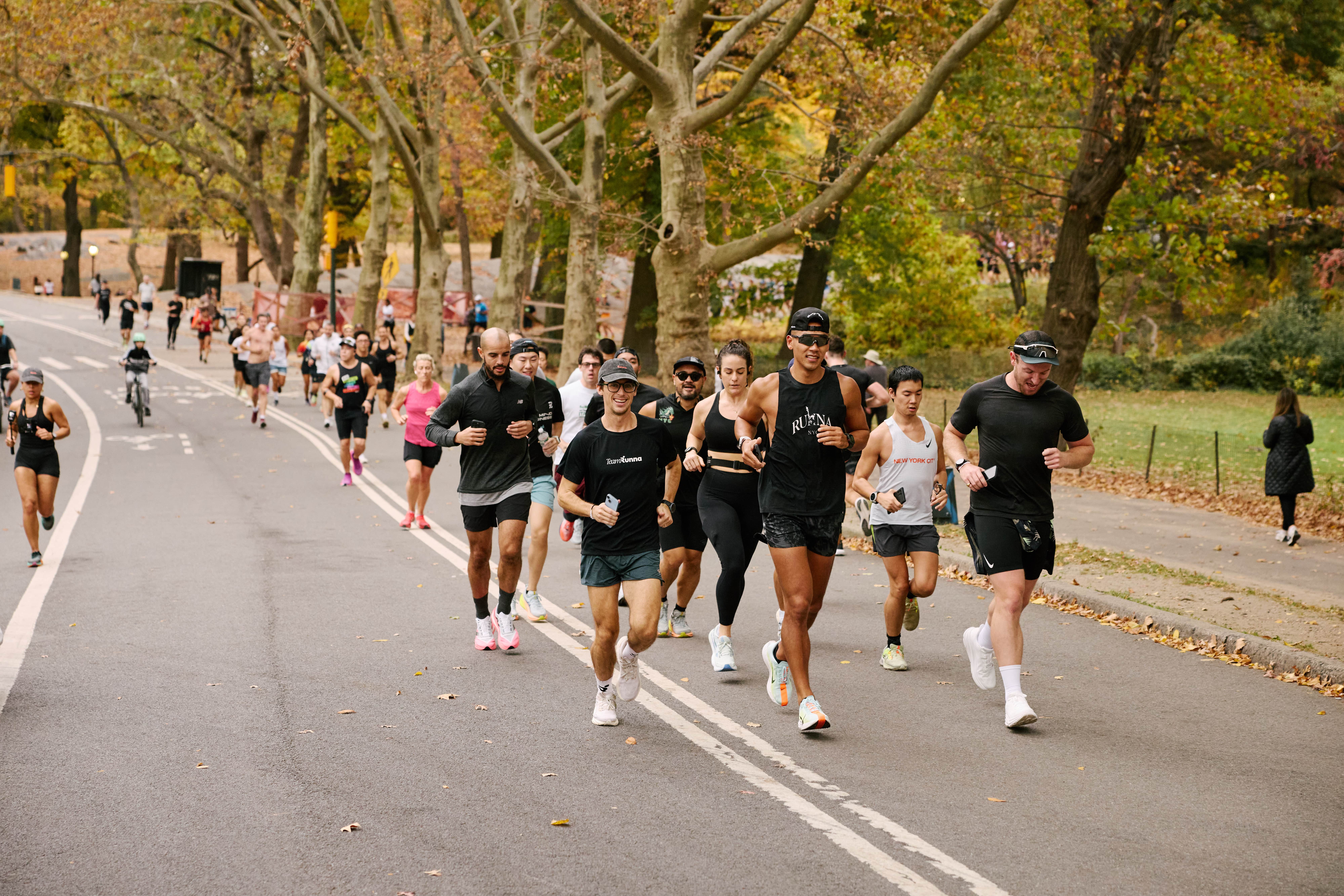Running plans to run further and longer
As runners, we know there’s something deeply rewarding about going the distance. Whether you’re building toward a future race or simply love the steady rhythm of longer runs, developing endurance creates confidence and lasting fitness. Our Run Further training plan helps you safely increase your mileage, build aerobic strength, and establish sustainable habits, without the pressure of chasing a race goal.

Running plans to run further and longer
As runners, we know there’s something deeply rewarding about going the distance. Whether you’re building toward a future race or simply love the steady rhythm of longer runs, developing endurance creates confidence and lasting fitness. Our Run Further training plan helps you safely increase your mileage, build aerobic strength, and establish sustainable habits, without the pressure of chasing a race goal.

What is a Run Further plan?
A Run Further plan is a structured training program designed to help you steadily increase your weekly mileage and build long-term endurance, without working toward a specific race. Whether you're looking to lay the groundwork for future goals, recover gradually after an event, or simply enjoy running longer distances, this plan supports consistent, sustainable progress beyond the race calendar.
At its core, Run Further is about building aerobic capacity and physical resilience. You'll complete weekly long runs that increase gradually over time, supported by easy runs and steady efforts that develop your endurance safely. This structure allows your body to adapt to higher volumes while reducing the risk of injury or burnout.
Unlike traditional race-focused plans, Run Further is built for year-round training. You define your current and target mileage, and we guide you toward it at a pace that fits your schedule and experience. You won’t find short-term intensity here. Instead, you’ll develop strength and stamina that stay with you long after the plan ends.
This plan is fully personalized based on your ability, availability, and current mileage, making it perfect for runners who want to build a strong foundation. Whether you're preparing your body for a future marathon cycle, increasing your volume for general fitness, or simply discovering how far you can go, Run Further gives you the structure and flexibility to grow your running base...on your terms.

Take your running to the next level

Take your running to the next level
Choose a personalized plan to reach your goals
One of the most effective ways to build long-term running fitness is to follow a personalized Run Further training plan that matches your current mileage, future goals, and weekly routine. Whether you're preparing to train for a marathon, increasing your volume for overall fitness, or just want to enjoy longer, more fulfilling runs, this plan gives you the structure and flexibility to grow your endurance with confidence.
A well-designed endurance-focused plan doesn’t just help you run further, but also strengthens your aerobic base, reduces the risk of injury, and improves your ability to hold steady effort over time. With a thoughtful mix of long runs, easy runs, and sustained steady-state sessions, you'll increase mileage gradually and safely while avoiding overtraining.
With Runna, you get a Run Further plan that:
- Lays out every session for you, tailored to your ability
- Progresses your mileage steadily based on your current level
- Includes deload weeks and strength workouts to support long-run performance
- Adapts to your training as your fitness evolves
Having a personalized endurance plan helps you stay consistent, avoid guesswork, and work towards bigger running goals, even if there’s no race in sight. It’s your roadmap to running stronger and further, one week at a time.
Choose to run faster
The Run Faster plan is designed to help you improve your pace, sharpen your running form, and build lasting speed. Ideal for runners who want to boost their 5k or 10k times, feel quicker on everyday runs, or rebuild speed between training blocks, this plan focuses on quality over quantity with targeted, high-intensity workouts. Unlike Run Further, which centers on gradually increasing mileage for endurance, Run Faster prioritizes speed. It’s perfect if your goal is to get faster, not necessarily go longer.
Choose to maintain
The Run to Maintain plan is ideal for runners looking to stay consistent, active, and injury-free without the intensity of structured race training. Whether you're in between events, navigating a busy schedule, or just want to keep running part of your routine, this plan offers a steady, low-pressure structure that supports your current fitness level. Unlike Run Further, Run to Maintain avoids major mileage increases or tough intervals. It’s all about preserving your fitness and enjoying the rhythm of running, without the stress of chasing performance goals.
Choose to run your own way
Train Your Way is our most adaptable plan, built to give you full control over your training. You choose your focus: speed, endurance, or a balanced mix. You set your mileage goals, and decide how many days you want to run each week. Whether you’re running for fitness, mental wellbeing, or to complement another sport, this plan flexes to fit your lifestyle. Unlike Run Further, Train Your Way is designed for freedom and personalization. It’s ideal for runners who want structure that supports their goals.

Take your running to the next level
Cross-training and strength training to run further
To run further, it’s not just about adding more miles each week. Two of the most powerful ways to build endurance safely and sustainably are cross-training and strength training. Together, they create a stronger, more balanced runner, capable of handling longer distances with greater efficiency and fewer injuries.
Cross-training activities like cycling, swimming, rowing, or hiking give your heart and lungs a solid workout without the repeated impact of running. These low-impact forms of cardio allow you to build aerobic capacity while giving your joints and muscles a break. On recovery days or during step-back weeks, cross-training can help maintain your fitness and support long-term progression without burnout.
Strength training plays a vital role in preparing your body for the physical demands of increased mileage. Targeted exercises that strengthen the glutes, hamstrings, calves, and core help you maintain form during long runs, reduce energy waste, and protect against overuse injuries. As your long runs extend, it’s this strength and stability that help you finish strong and recover well.
When used consistently, cross-training and strength work complement your running perfectly. They help you build endurance while staying injury-free, maintain consistency across your training weeks, and develop the muscular and cardiovascular durability needed to go the distance.
With our Run Further plan, these elements are seamlessly integrated into your schedule, so you can focus on building mileage while training smarter, staying stronger, and feeling confident every step of the way.
Distance vs speed: what's best?
Choosing whether to focus on speed or distance can be challenging, but the right answer depends entirely on your current goals and what kind of runner you want to become.
Speed-focused training is designed to improve your pace, explosiveness, and running economy. It’s built around high-intensity sessions like intervals, tempo runs, and strides, all of which place short-term stress on your cardiovascular system to yield long-term performance gains. Speed training is ideal if you want to chase a PB, feel quicker on your runs, or sharpen your form and responsiveness. You’ll also find that once your speed improves, even your easy runs start to feel easier and more efficient.
In contrast, distance-focused training is about building stamina, aerobic depth, and mental resilience. These plans feature progressive long runs, steady-state efforts, and consistent weekly mileage designed to increase your ability to go further, comfortably and confidently. Distance training lays the foundation for future race blocks, supports injury prevention, and helps establish strong training habits that last.
So, which one should you choose?
If you’re excited by the idea of running further than ever before, a distance-focused plan like Run Further is your best fit. If you're more focused on refining pace or hitting performance targets in shorter events, Run Faster is the better choice.
But ultimately, neither is better than the other. Each has its place, depending on where you are in your training journey. The key is picking the path that excites you most right now. And, with us, you can always switch between plans as your goals evolve.
The different types of speed training explained
If your goal is to run further, you need more than just longer runs: you need a thoughtful blend of training types that build endurance, improve recovery, and support your body through progressive mileage increases. The Run Further plan combines these elements to help you go the distance confidently and sustainably.
Long runs are the cornerstone of this plan. Gradually increasing in duration, they strengthen your aerobic base, train your body to handle extended efforts, and build the mental resilience needed for longer distances. Each week, your long run gently stretches your limits while allowing time for adaptation.
Steady-state efforts are sustained runs at a moderate intensity: comfortably hard but maintainable. These help you develop pacing control, efficiency, and aerobic capacity. They’re not as intense as speed sessions but offer a valuable middle ground between easy and hard running, making them ideal for building up distance without overexerting.
Easy runs are the foundation that keeps your training consistent and safe. These relaxed-pace runs allow your body to recover while still maintaining mileage. They help build strength, improve circulation, and reduce the risk of injury, especially as your weekly volume increases. Easy running also supports overall enjoyment, helping you stay motivated for the long term.
Optional tempo or interval sessions may appear occasionally, especially if you opt for a balanced focus. These provide a small amount of intensity to maintain well-rounded fitness but are always secondary to the goal of endurance.
The 80/20 rule still applies. This ratio allows you to safely increase mileage while remaining strong and injury-free. It’s this sustainable approach that makes the Run Further plan ideal for anyone looking to build endurance, step up to longer distances, or prepare for future race training blocks.
As featured in




Distance training gear: shoes, clothing, and more
The gear you use during training can make a significant difference in your comfort, endurance, and ability to train consistently over time. Especially when you’re increasing your mileage, having the right kit helps you avoid injury, stay motivated, and enjoy the journey toward running further.
- Shoes are your most essential piece of gear. A supportive, well-fitted pair can absorb impact, reduce fatigue, and help prevent injury as your runs get longer. Visiting a specialist running store that offers gait analysis or treadmill testing can help you find a shoe that matches your stride and foot shape, something that becomes even more important as weekly mileage increases.
- Clothing made from technical, sweat-wicking fabrics like polyester or nylon helps regulate temperature and prevent chafing. These materials keep you dry and comfortable, especially during longer efforts or back-to-back training days. Cotton, which holds moisture and increases friction, is best avoided.
- GPS-enabled devices or running watches can help you track your distance, pace, and progress across longer training cycles. Whether you use a Garmin, Apple Watch, COROS, or your phone, syncing with Runna ensures your plan and data stay in perfect alignment. This makes it easier to monitor your progress and keep building over time.
- Accessories such as hydration vests, belts, or handheld bottles become especially useful on long runs. Staying fueled and hydrated is key when you’re running further, particularly in warmer conditions. Carrying essentials like nutrition, keys, and your phone ensures you’re prepared for every session.
- Sun protection is also key. Even on cloudy days, UV rays can affect your skin during extended time outdoors. A high-SPF sunscreen, paired with a cap or sunglasses, adds comfort and keeps you protected during your longest runs.
Choosing the right gear helps you run further, more comfortably, and with the confidence to keep going.
Take your running to the next level
Take your running to the next level
/Homepage/girls-running-a-marathon.webp)
/Homepage/girl-running-with-hands-up.webp)
/Homepage/girls-hugging.webp)
/Homepage/people-running-a-marathon.webp)
Our partners






































